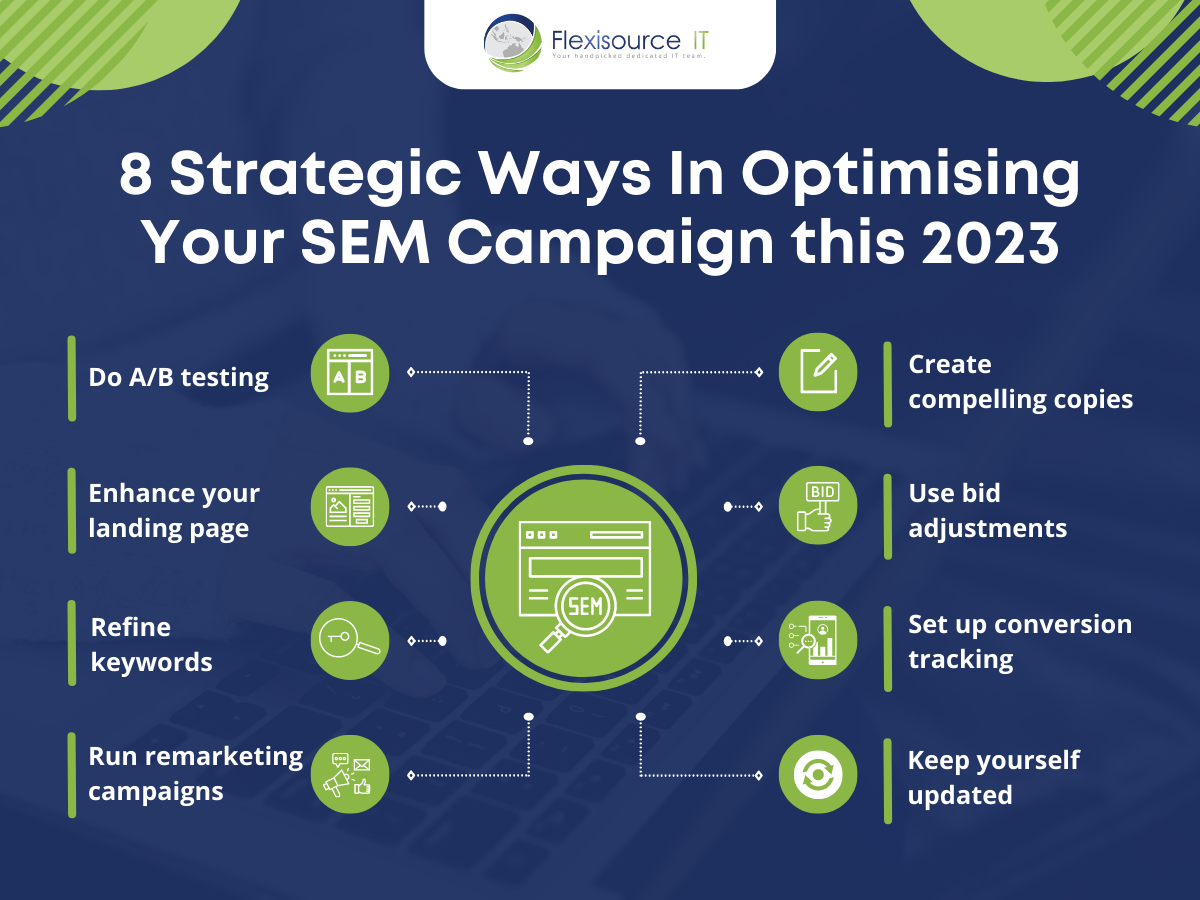Today, many businesses use Search Engine Marketing (SEM) to drive traffic, surge revenue, and reach potential customers. SEM has provided companies a huge opportunity to increase sales at a relatively low cost per acquisition.
However, SEM campaigns can do more harm than help when improperly implemented. Some have lost thousands of dollars when running SEM campaigns due to improper planning or premature execution.
This article will help you understand what SEM is, its benefits, and some ways to optimise your SEM campaigns.
Table of Contents
What is Search Engine Marketing?
Search engine marketing (SEM) is obtaining a high ranking in search engine results pages (SERPs) through organic or paid search result listings. SEM includes both pay-per-click advertising and organic search engine optimization.
This form of marketing is beneficial for businesses with a small budget since it allows them to reach a wider audience without spending more money on advertising. There are many different types of Search Engine Marketing, and they can be classified as follows:
- Organic Search Engine Marketing
- Paid Search – PPC or Pay Per Click
- Display Advertising
- Email Marketing
- Social Media Marketing
- Video Marketing
What are the benefits of SEM Campaigns?
Search engine marketing is a type of marketing that utilizes paid advertising on search engines to generate leads. It is a form of internet marketing and has been demonstrated to be an effective way to generate website traffic. When you launch a properly optimised SEM campaign, it can bring various benefits. Below are just some of the benefits you can expect:
- Increase in website traffic
- Amplify brand awareness through increased visibility on the web
- Invite more visitors to your site
- Get more qualified leads who are more likely to convert into customers
- Increase conversion rates
How to Optimise Your SEM Campaigns?
Research is the most important thing to do before optimizing your SEM campaigns. You need to know who your target users are, what keywords they are searching for, and what kind of content they like.
Once you have done all the research and have a good idea about what you will be marketing, it’s time to start. Here are some methods on how you can optimise your SEM campaigns.

1. Do A/B testing
A/B testing is one way to optimise your SEM campaigns. The main goal for any A/B tests is to figure out what changes you must make for your website to be more successful.
You can test your campaign using two versions of a webpage to see which one performs better.
- A/B Split test. This type of test will have two versions of the same page and determine which one performs better.
- Multivariate test. This type of test will have more than two different versions of the same page and determine which ones perform best in what situations.
2. Enhance your landing page
The next step is creating the landing page that people will click on. This page should be designed so that people will be convinced to purchase your product or avail of your services. Moreover, to maximize your chances of getting a conversion, it’s crucial to have a professional-looking landing page that converts well.
Creating an optimized landing page is not easy; it takes time and patience to get it right. First, you need to show what you want the end user to do when they land on your site. The next step is figuring out what will be on the page that will help them convince to create an action.
3. Refine keywords
Another way to optimise your SEM campaign is by refining your keywords. Keyword research is vital for the success of an ad campaign. It helps you find what people are actively searching for and increases your chances of getting your ad in front of them.
There are a few ways to do keyword research. Still, one of the most popular ones is using various Keyword Tools such as Ahrefs, Keyword Everywhere, and more. This type of tool allows you to enter a phrase, and it will provide you with a list of related keywords. It also shows how popular these keywords are, which is crucial if you’re looking to target more competitive ones with less competition and higher search volume.
Another way of doing keyword research is by using Google Keyword Planner. It is an easy tool to use. You just need to ensure that it is connected to your Google Ads account to get exact keywords.
4. Run remarketing campaigns
Remarketing campaigns are a marketing strategy that allows companies to show ads to people who have visited their website or used their app. It uses targeted advertising on social media platforms, websites, and mobile applications to reach people who have previously visited the advertiser’s site or app.
5. Create compelling copies
Great content or copies are another great way to optimise your SEM campaigns. Having high-quality copies are a great way to fascinate the target audience and drive them to patronise your product.
There are many ways to make compelling copy for advertisements. First, you need to do is to understand the product or service that you are selling. You need to know what it does and how it works so that you can convince the customer why they should buy it.
The next step is to create a headline for your campaign. The headline should be catchy and engaging so that people will want to read what’s in the ad. Ensure your headline is specific and not too general because people will not be interested in anything too vague or general.
Lastly, make sure you have a call-to-action at the end of your ad so that people know what they should do after reading it.
6. Use bid adjustments
Bid adjustment in search engine advertising is a strategy that allows advertisers to set different bids for various parts of their campaigns. It’s a powerful tool that can be used to target specific audiences and increase the ROI of your campaigns.
The primary function of bid adjustment is to optimize the spending on different parts of your campaign. This can be done by setting up an auction-based system and bidding on keywords to target specific audiences and increase ROI.
7. Set up conversion tracking
Conversion is the most crucial metric for SEM. The conversion rate is the number of people who take action divided by the number of people who see your ad. You can generate more leads and sales if you have a high conversion rate.
As such, it’s important to constantly track and monitor your conversions to further optimise your SEM campaigns. The first step is to create a conversion goal. This will be the “objective” we are trying to achieve with our SEM campaign. For example, if we are running a campaign for an e-commerce website, the conversion goal could be the number of people who buy something from our site.
Next, you need to set up your tracking code. This is where you put your website URL and the name of your conversion goal. You must also select which channels to track conversions (such as Google search or Facebook).
8. Keep yourself updated
Lastly, you must keep yourself updated to optimise your SEM campaigns further. Trends are one of the most critical data you must have in your campaign. It can teach you what people are looking for or tell you something about the future.
And as a marketer, you must always align your SEM campaigns with the trends.
Optimise Your SEM Campaign with Flexisource IT Specialist.
These are just a few tips for optimizing your SEM campaign. Through these tricks, you will surely be able to target your customers and increase your revenue. But if you are not experienced in managing your SEM campaign, it’s best to let a professional handle it.
And our specialists can help you! We have skilled and certified SEM specialists in our company. Contact us now!
Pamela is a full-time content writer and a lifelong Philomath. Her previous experience as a research analyst made her passionate about traveling the world and understanding how it works. During her day off, you can often find her indoors, writing stories or oil painting.


